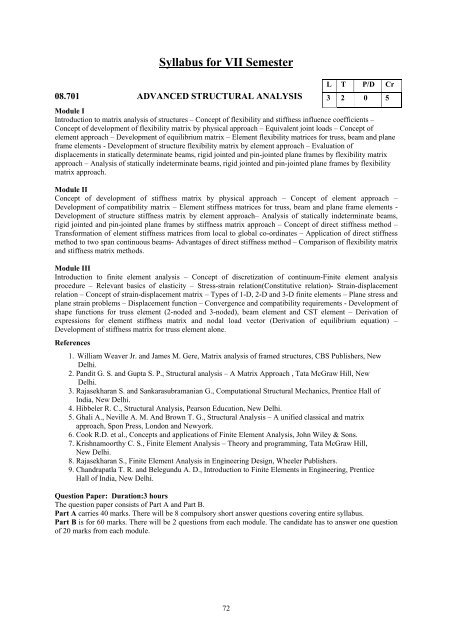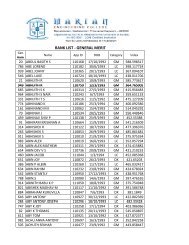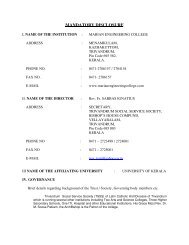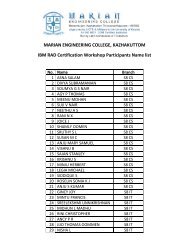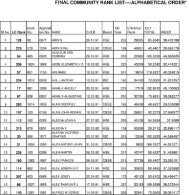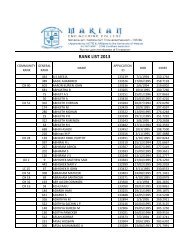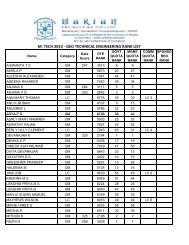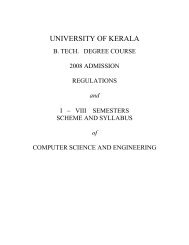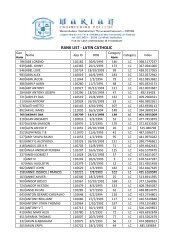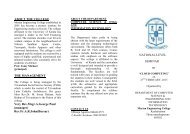UNIVERSITY OF KERALA - College of Engineering, Trivandrum
UNIVERSITY OF KERALA - College of Engineering, Trivandrum
UNIVERSITY OF KERALA - College of Engineering, Trivandrum
Create successful ePaper yourself
Turn your PDF publications into a flip-book with our unique Google optimized e-Paper software.
Syllabus for VII Semester<br />
08.701 ADVANCED STRUCTURAL ANALYSIS<br />
L T P/D Cr<br />
3 2 0 5<br />
Module I<br />
Introduction to matrix analysis <strong>of</strong> structures – Concept <strong>of</strong> flexibility and stiffness influence coefficients –<br />
Concept <strong>of</strong> development <strong>of</strong> flexibility matrix by physical approach – Equivalent joint loads – Concept <strong>of</strong><br />
element approach – Development <strong>of</strong> equilibrium matrix – Element flexibility matrices for truss, beam and plane<br />
frame elements - Development <strong>of</strong> structure flexibility matrix by element approach – Evaluation <strong>of</strong><br />
displacements in statically determinate beams, rigid jointed and pin-jointed plane frames by flexibility matrix<br />
approach – Analysis <strong>of</strong> statically indeterminate beams, rigid jointed and pin-jointed plane frames by flexibility<br />
matrix approach.<br />
Module II<br />
Concept <strong>of</strong> development <strong>of</strong> stiffness matrix by physical approach – Concept <strong>of</strong> element approach –<br />
Development <strong>of</strong> compatibility matrix – Element stiffness matrices for truss, beam and plane frame elements -<br />
Development <strong>of</strong> structure stiffness matrix by element approach– Analysis <strong>of</strong> statically indeterminate beams,<br />
rigid jointed and pin-jointed plane frames by stiffness matrix approach – Concept <strong>of</strong> direct stiffness method –<br />
Transformation <strong>of</strong> element stiffness matrices from local to global co-ordinates – Application <strong>of</strong> direct stiffness<br />
method to two span continuous beams- Advantages <strong>of</strong> direct stiffness method – Comparison <strong>of</strong> flexibility matrix<br />
and stiffness matrix methods.<br />
Module III<br />
Introduction to finite element analysis – Concept <strong>of</strong> discretization <strong>of</strong> continuum-Finite element analysis<br />
procedure – Relevant basics <strong>of</strong> elasticity – Stress-strain relation(Constitutive relation)- Strain-displacement<br />
relation – Concept <strong>of</strong> strain-displacement matrix – Types <strong>of</strong> 1-D, 2-D and 3-D finite elements – Plane stress and<br />
plane strain problems – Displacement function – Convergence and compatibility requirements - Development <strong>of</strong><br />
shape functions for truss element (2-noded and 3-noded), beam element and CST element – Derivation <strong>of</strong><br />
expressions for element stiffness matrix and nodal load vector (Derivation <strong>of</strong> equilibrium equation) –<br />
Development <strong>of</strong> stiffness matrix for truss element alone.<br />
References<br />
1. William Weaver Jr. and James M. Gere, Matrix analysis <strong>of</strong> framed structures, CBS Publishers, New<br />
Delhi.<br />
2. Pandit G. S. and Gupta S. P., Structural analysis – A Matrix Approach , Tata McGraw Hill, New<br />
Delhi.<br />
3. Rajasekharan S. and Sankarasubramanian G., Computational Structural Mechanics, Prentice Hall <strong>of</strong><br />
India, New Delhi.<br />
4. Hibbeler R. C., Structural Analysis, Pearson Education, New Delhi.<br />
5. Ghali A., Neville A. M. And Brown T. G., Structural Analysis – A unified classical and matrix<br />
approach, Spon Press, London and Newyork.<br />
6. Cook R.D. et al., Concepts and applications <strong>of</strong> Finite Element Analysis, John Wiley & Sons.<br />
7. Krishnamoorthy C. S., Finite Element Analysis – Theory and programming, Tata McGraw Hill,<br />
New Delhi.<br />
8. Rajasekharan S., Finite Element Analysis in <strong>Engineering</strong> Design, Wheeler Publishers.<br />
9. Chandrapatla T. R. and Belegundu A. D., Introduction to Finite Elements in <strong>Engineering</strong>, Prentice<br />
Hall <strong>of</strong> India, New Delhi.<br />
Question Paper: Duration:3 hours<br />
The question paper consists <strong>of</strong> Part A and Part B.<br />
Part A carries 40 marks. There will be 8 compulsory short answer questions covering entire syllabus.<br />
Part B is for 60 marks. There will be 2 questions from each module. The candidate has to answer one question<br />
<strong>of</strong> 20 marks from each module.<br />
72


